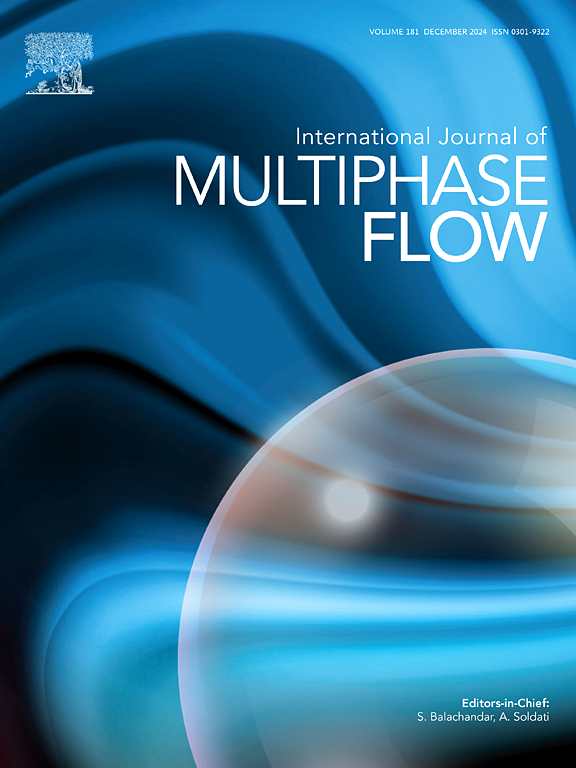Force model for a stationary finite-size spherical particle in compressible turbulence
IF 3.8
2区 工程技术
Q1 MECHANICS
International Journal of Multiphase Flow
Pub Date : 2025-09-30
DOI:10.1016/j.ijmultiphaseflow.2025.105465
引用次数: 0
Abstract
In this study, the force model for a finite-size stationary spherical particle in a compressible turbulent flow is numerically investigated from particle-resolved direct numerical simulations at various Mach numbers with a ghost-point immersed boundary method. We first show that it makes insignificant difference whether the volume-averaged or surface-averaged physical quantity is used in the force model, and whether the Reynolds and Mach numbers are obtained by using averaged parameters (e.g., average slip velocity, density, viscosity) or by averaging the local Reynolds and Mach numbers, respectively. Averaging followed by differentiation is better than differentiation followed by averaging for the calculation of the momentum derivative term in the inviscid-unsteady force. From our results, it is a good choice to just use the quasi-steady and undisturbed forces to predict the force on the finite-size particles in compressible turbulence, particularly for the supersonic case with the particle Mach number above 1. For the subsonic case, the inclusion of the inviscid-unsteady force improves the prediction accuracy for the streamwise force and the inclusion of all types of forces is most accurate for the lateral force. When the slip velocity is calculated from the disturbed average fluid velocity on a spherical surface, the surface with the radius being one particle diameter provides the best prediction for the quasi-steady force on the particle in turbulence. However, the accuracy of this method for the prediction of the instantaneous force is much lower than the approach of calculating the undisturbed velocity from the simulation without the particle.

可压缩湍流中固定有限尺寸球形颗粒的力模型
本文采用鬼点浸入边界法对可压缩湍流中有限尺寸静止球形颗粒在不同马赫数下的直接数值模拟进行了数值研究。我们首先表明,无论是在力模型中使用体积平均物理量还是表面平均物理量,以及通过使用平均参数(例如,平均滑移速度、密度、粘度)还是分别平均局部雷诺数和马赫数来获得雷诺数和马赫数,两者之间的差异都不显著。计算非粘性非定常力的动量导数项时,先求平均后求微分优于先求微分后求平均。从我们的结果来看,在可压缩湍流中,特别是在粒子马赫数大于1的超音速情况下,仅使用准定常力和非扰动力来预测有限大小粒子的力是一个很好的选择。在亚音速情况下,包含非粘性非定常力提高了流向力的预测精度,而包含所有类型的力对侧向力的预测精度最高。从球面上的扰动平均流体速度计算滑移速度时,半径为一个颗粒直径的表面对湍流中颗粒所受的准定常力的预测效果最好。然而,该方法对瞬时力的预测精度远低于从无粒子的模拟中计算无扰动速度的方法。
本文章由计算机程序翻译,如有差异,请以英文原文为准。
求助全文
约1分钟内获得全文
求助全文
来源期刊
CiteScore
7.30
自引率
10.50%
发文量
244
审稿时长
4 months
期刊介绍:
The International Journal of Multiphase Flow publishes analytical, numerical and experimental articles of lasting interest. The scope of the journal includes all aspects of mass, momentum and energy exchange phenomena among different phases such as occur in disperse flows, gas–liquid and liquid–liquid flows, flows in porous media, boiling, granular flows and others.
The journal publishes full papers, brief communications and conference announcements.

 求助内容:
求助内容: 应助结果提醒方式:
应助结果提醒方式:


